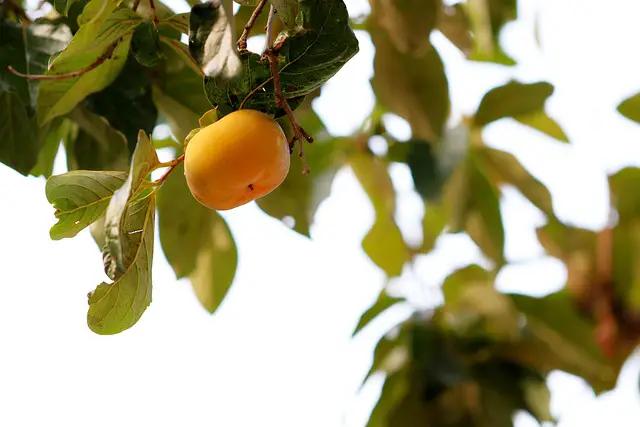
We may receive commissions from purchases made through links in this post, at no additional cost to you.
Pruning trees can be an art form. Arborists study for years exactly how to make certain cuts to get the result they want. But in the home garden, especially with fruit trees, pruning can be an intimidating and confusing process.
Every type of tree grows differently, which means they need to be pruned differently. Persimmon trees are no exception to this. When it comes to pruning Asian persimmon trees in particular, understanding how the tree grows and what you are trying to accomplish is key.
Asian persimmon trees are pruned when they are young to establish form and limit size. As they mature, pruning should focus on maintaining the shape and ensuring that light reaches the ripening fruit. Moderate annual pruning will increase the fruit’s quality, size, and reachability.
Even easy-to-grow fruit trees like persimmons can benefit from some pruning. In this article, I’ll walk you through exactly how to prune your persimmon tree. The good news is, once the main shape is established, lightly pruning every year will be a breeze.
When to Prune an Asian Persimmon Tree
It is certainly acceptable to just let your persimmon tree grow unhindered and never touch it with pruning shears. Compared with other fussy fruits, such as peaches, persimmon trees are relatively easy to grow and will probably thrive with little intervention. Check out Growing Persimmon Trees: How Hard Is It? to read more about what makes persimmon trees a great choice for low-maintenance gardens.
If you have garden space to fill and can let your Asian persimmon grow to its full height of 15 feet or so – and if you don’t mind mounting a ladder to reach the fruit – then you can probably skip pruning. But if you want to keep your tree compact, maximize its fruiting potential, and keep the fruit reachable, then pruning is essential. (Learn about the potential mature size of a persimmon tree in this article.)
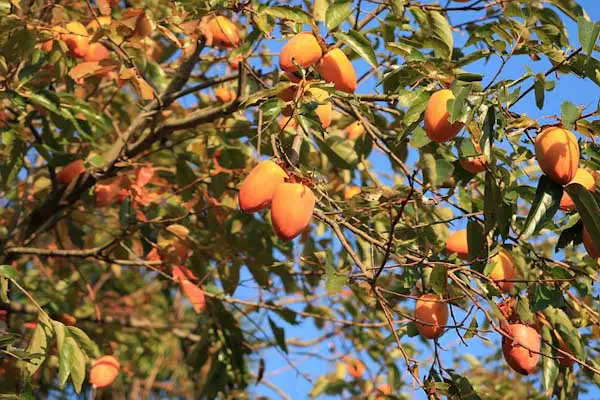
Pruning accomplishes different things depending on when it’s done in the growing season. Winter is the time to remove dead or problematic growth, establish shape, and set things up for a productive season. Summer pruning is all about trimming broken or problematic branches and removing growth that shades the ripening fruit.
While the persimmon tree is young, most of the pruning will take place in winter while the tree is dormant. Young trees are more resilient, so the somewhat more aggressive pruning to establish form won’t be a problem. As the tree grows, and if you’ve already done the work to set up a good tree shape, then winter pruning will be less and less.
As the tree gets older, summer pruning will be more important. An older tree means a more dense canopy, so it may be necessary to thin the branches so the ripening persimmons receive adequate light. A mature tree may still need some dormant pruning, but mostly just to get rid of dead or damaged wood and maintain the desired size.
In general, dormant pruning is less stressful for the tree because it is in a state of suspended growth. Excessive pruning during the growing season, especially in the heat of summer, could cause the tree stress. If you have significant trimming to do, best to keep it at the end of winter before the buds start to break.
This article is focused on winter pruning, as that’s when the bulk of the pruning should happen (especially with a younger tree). I’ll also include tips for summer pruning where it’s relevant.
Step 1: Gather Your Tools
The tools of the job are simple, and even a casual gardener should be sure to have these things on hand. Speaking from experience, it is worth investing in quality tools. They’ll last longer (maybe a lifetime), perform better, and are easier to maintain.
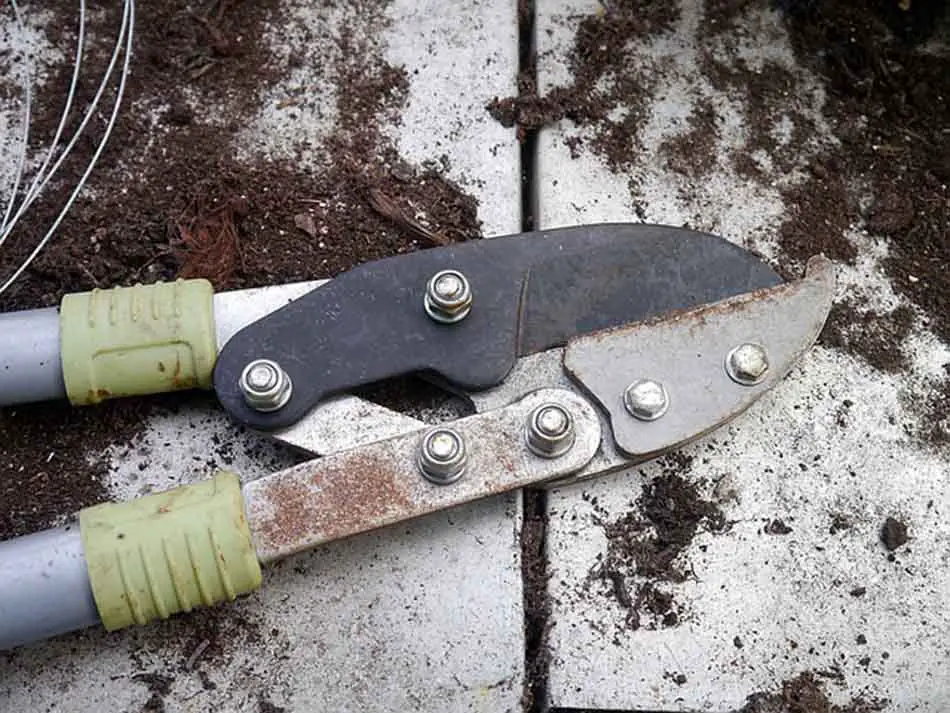
It is essential to clean and sanitize your tools before making any cuts. You’ll be cutting and sawing into the tender inner parts of branches. Any trace of bacteria, fungal spores, rust, or grime on the tools could spread disease to the exposed tissue.
After cleaning visible dirt, thoroughly wipe the tools with rubbing alcohol to disinfect them. White vinegar is another readily available option, although little research has been done as to how affective it is in removing plant pathogens. You can also soak the tool in a solution of bleach and water (up to 10% bleach to 90% water) for 30 minutes to sterilize, although be careful, as this can be corrosive to metal.
Here’s what you need before you begin pruning:
- Heavy-duty hand pruners. Use hand pruners to trim any branches that are 1/2 inch or smaller in diameter. I prefer these Felco 2 hand pruners. They are high quality, last a long time, and you can easily purchase replacement parts if needed.
- Pruning saw. A saw is essential for removing branches thicker than about a 1/2 inch. You want as clean and straight a cut as possible, and hand pruners can compress thicker branches. I like this hand saw for quality and durability.
- Gardening gloves. Holding and using the tools will just be more comfortable with gloves on. They’ll also provide protection from scratches or accidental nicks from the sharp tools (long sleeves and pants will also help). I use a leather pair of gloves like this one.
- Stepladder. If you are pruning to keep your tree compact, you may not even need this. But have one just in case for removing higher growth and minimizing awkward reaching.
REMINDER: Always thoroughly clean and sanitize pruning tools before making any cuts. Open plant wounds are more susceptible to disease, and tools are a common way for pathogens to spread. Do not skip this step!
Step 2: Assess Your Tree
Before making any cuts, take a moment to analyze the tree. Observation will help you make some initial pruning decisions. You may change your mind later in the process, but it’s best to start with a rough plan.
When winter pruning, have a look at your dormant persimmon tree as it is right now. What is its current shape? Look at the trunk and branches. Does it have one main trunk or multiple trunks? How many branches come off of the trunk, and how are they placed? Looking at the overall form, is it what you like, or do you want to change it?
Next, pay attention to how the tree is growing. Do you notice any crossing branches, or branches that have grown too long or too low to the ground? Check for dead or damaged growth, or suckers growing near the base of the tree.
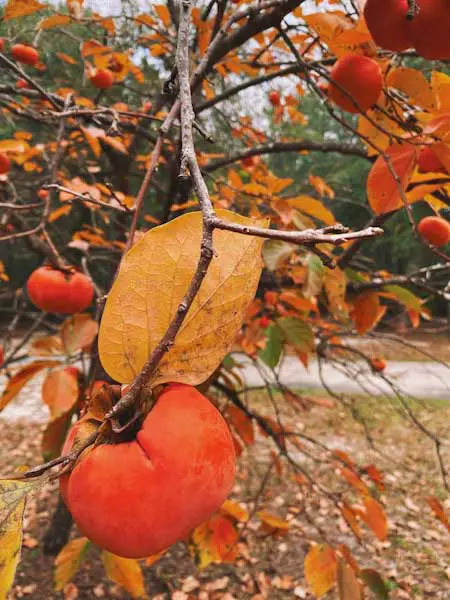
Decide what your main priority is. Do you want the tree to take up visual space in the garden and be mostly ornamental? Or is it important to you to be able to reach all of the fruit easily? Do you need to keep the tree compact because of space constraints?
When summer pruning, look for water sprouts (those fruitless thin shoots that grow straight up from the trunk or other branches) and root suckers. Also check out the persimmons themselves. Are any areas of the tree (especially the interior) too shaded? Is each persimmon able to get enough light to ripen properly?
Step 3: The 3 Ds – Dead, Diseased, Damaged
It’s finally time to pick up your pruning shears and saw. The first cuts you make should remove any dead, diseased, or damaged growth (known as the 3 Ds of pruning…you could include many others, such as dying, dangerous, deformed, or damn ugly, but I think 3 is easier to remember). The goal is to get rid of anything that could stress the tree or cause future issues.
This is a good time to talk about what a good pruning cut looks like. If you are removing an entire branch or twig, cut it off cleanly at the base as close to the trunk (or main branch) as possible. These are called thinning cuts, because they are used to thin out growth without encouraging new branches to grow.
Heading cuts, on the other hand, are angled cuts used to shorten branches just above a bud. These cuts are used to influence the growth of a tree. When the end of a branch is cut off, that signals the tree to send out new growth from the few buds below the cut.
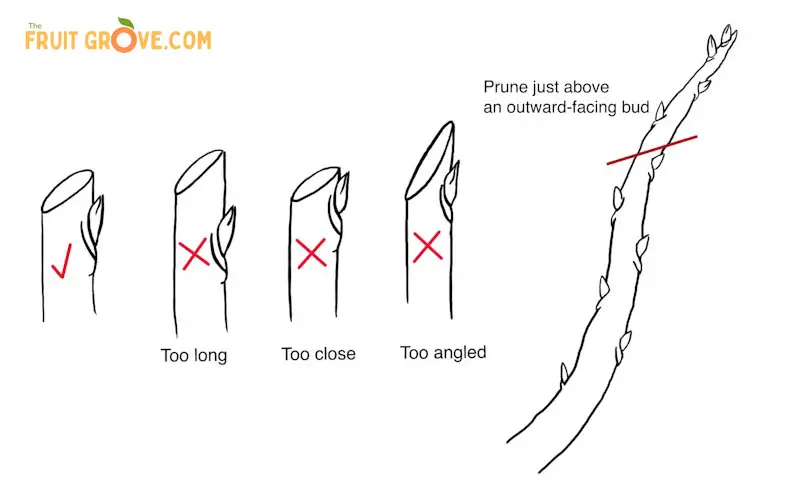
Make heading cuts about 1/4 inch above a bud at a 45° angle. Keep your tools sharp so you can get as clean a cut as possible. Bad cuts that are jagged, at the wrong angle, or the wrong distance from a bud often cause further problems and invite disease.
Do this step when the tree is dormant, but check again in the summer. If any branches are damaged by wind or storms, or if you notice any dead or diseased branches you missed in the winter, go ahead and prune them now.
Step 4: Remove Weak, Crossing, or Inward-Growing Branches
Next, remove any growth that is growing inward toward the center of the tree. Thinning inward-growing branches will increase airflow and help light reach more of the tree. You want all of the branches to grow in an outward, spreading direction so nothing gets too crowded.
If you notice any weak-looking, small, wispy twigs, go ahead and remove those too. They really serve no purpose…and they’re just unattractive.
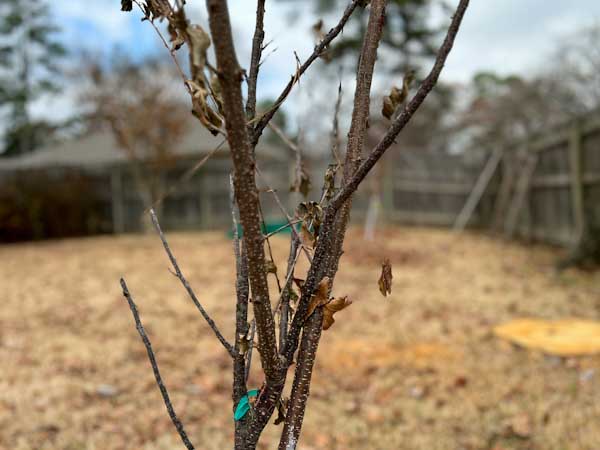
Check for any branches that are crossing over each other or growing close together. As these branches get thicker, they will grow too close together and compete. Remove one of the branches at its base, prioritizing keeping the outward-growing branch.
Step 5: Prune for Form
It’s time to make some decisions. Remember the plan you made at the beginning? Now’s a good time to step back and assess the tree again. Decide what you want your tree to look like, then go for it. Lean towards a “less-is-more” approach…you can always trim more later.
Most persimmon trees come pre-pruned when you buy them from the nursery, so hopefully you don’t have any drastic re-shaping cuts to make. There are three main forms for most fruit trees: open center, central leader, and modified central leader.
Trees that are very disease-prone, such as peaches, need to be in a V-shaped, open-center shape for maximum airflow and sun exposure. A persimmon tree could grow in a central leader form, but it would just keep growing higher and higher until the fruit was unreachable.
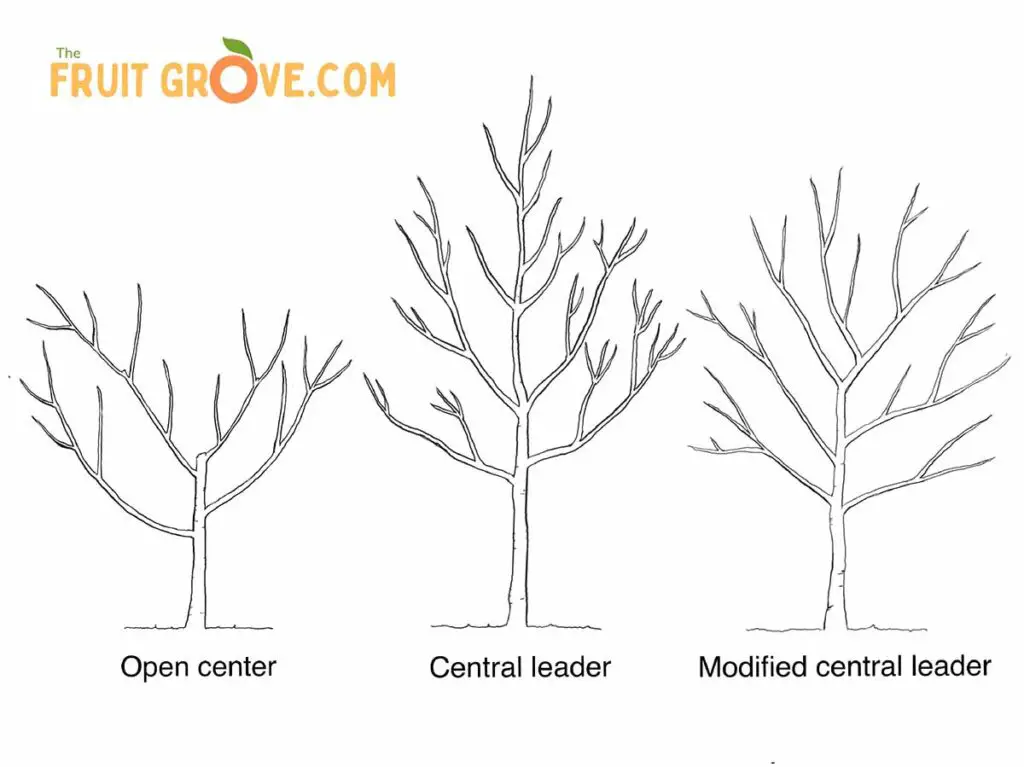
Asian persimmon trees tend to do well in a modified central leader shape. This means there’s one primary trunk, but it splits into two or three main branches a few feet from the ground. This form encourages outward-spreading branches and wide crotch angles (the angle where a branch meets the trunk), which are necessary to support heavy fruit loads. Plus the persimmons stay easier to reach.
In this step, first decide if you need to modify the form. Most of the time the main trunk has already been headed off at the nursery, but if it hasn’t, consider cutting the main trunk (central leader) 3-5 feet from the ground with an angled cut. This will keep the tree from getting too tall and will encourage scaffold branches to grow below this point.
Persimmons are a heavy fruit, and the branches tend to bow under the fruit’s weight. Remove any branches that are too low to the ground, as these may drag on the ground and invite rot (or wildlife snacking).
Pay attention to the direction the branches are growing. If you want a specific branch to spread outward, choose an outward-facing bud, then cut the branch at an angle about 1/4 to 1/2 inch above the bud. The tree will send out a new branch at that bud, in the direction it’s facing.
You can cut longer branches down by about 1/3 to 1/2 for shape. Keep stepping back and checking the balance of your tree. Walk all the way around and see if there’s anything you’ve missed.
When the tree is young, particularly after it has been established in the ground for a year or two, it can handle more pruning. Now is the time to make these shaping cuts, before you’ve had a significant crop of persimmons.
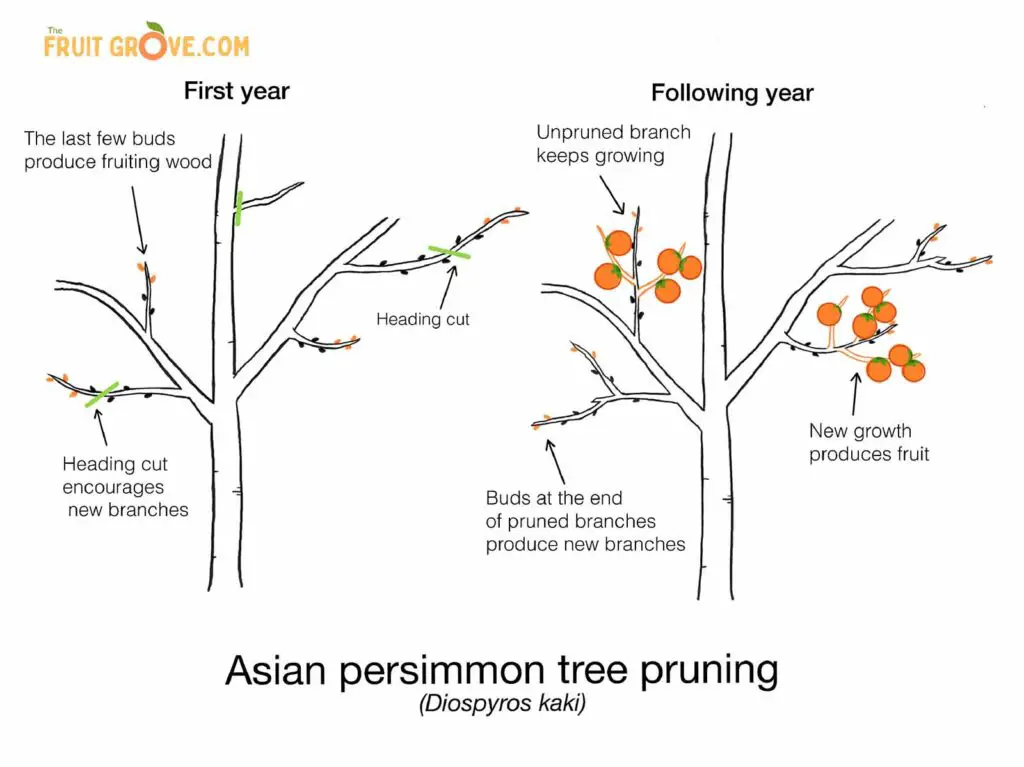
Unlike many other fruit trees, persimmon trees grow fruit off of new wood. The tree will send out new shoots from its buds in spring, and the fruit will form on those new shoots. No matter how long a branch is, the tree will grow new fruiting branches from its last few buds.
So, again, pay attention to the buds on any branches you decide to cut. This is where the fruiting shoots will come from. Persimmon trees tend to fruit more on outward growth, rather than vertical growth, so it can be a good idea to remove excessive vertical shoots.
Finally, remove any growth that is too high (if your goal is to keep the tree compact). After winter pruning, aim to keep the ends of the trees’ branches somewhere between chest height and eye level. That way, as the tree sends out new growth in spring, it will stay within easy reach.
At-A-Glance Persimmon Pruning Checklist
Here’s a handy reference as you set out to prune your persimmon tree. Read each section above for details, and use this checklist to keep track of what you need to do.
- STEP 1: Gather your tools.
- Heavy duty pruning shears, a pruning saw, gloves, protective clothing, stepladder
- STEP 2: Assess your tree.
- Check the overall shape. Is there anything you need to change or adjust?
- Check how the tree is growing. Are there too-long, too-close, or crossing branches? Do you see water sprouts or weak branches?
- Check the height of the tree. Will you be able to reach the ripe fruit?
- STEP 3: The 3 Ds – Dead, diseased, and damaged.
- Remove any growth that is dead, broken, wounded, or shows signs of disease.
- STEP 4: Remove weak, crossing, or inward-growing branches.
- In winter, prune anything growing toward the center of the tree, crossing over other branches, or that seems wispy and weak.
- In summer, remove water sprouts, root suckers, and excess growth that is shading ripening fruit.
- STEP 5: Prune for form.
- Prioritize outward-growing branches and those with a wide crotch angle. If pruning long branches, prune to just above an outward-facing bud.
- Trim branches at the top of tree to control size.
- Step back and look at the shape from all sides.
Remember, less is more! When in doubt, err on the side of less pruning. You can always take off more later. The good news is, there’s more than one right way to prune. If you give it a go, you’ll be rewarded with a healthier tree, better fruit, and a major sense of accomplishment.

